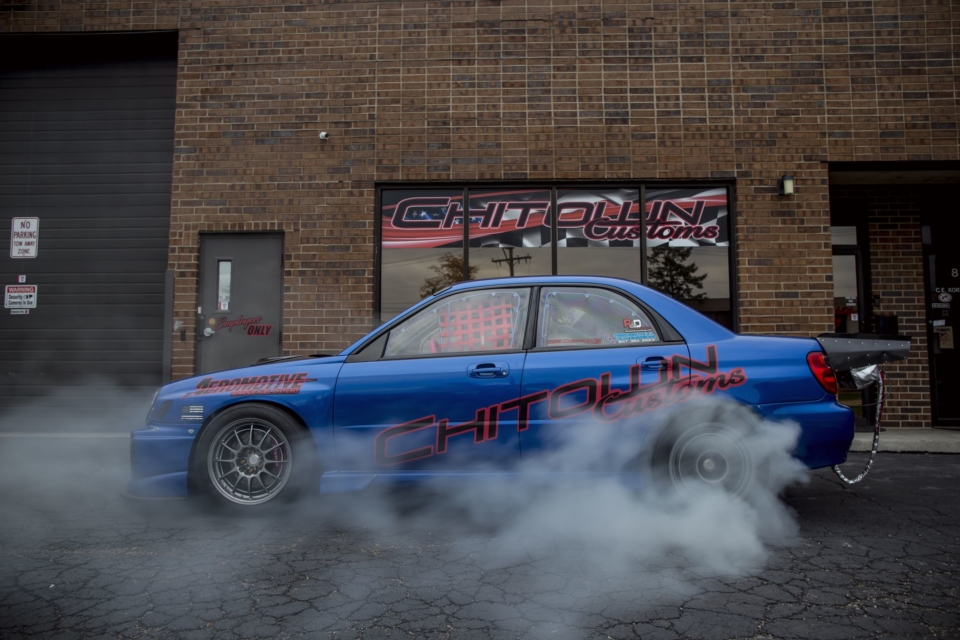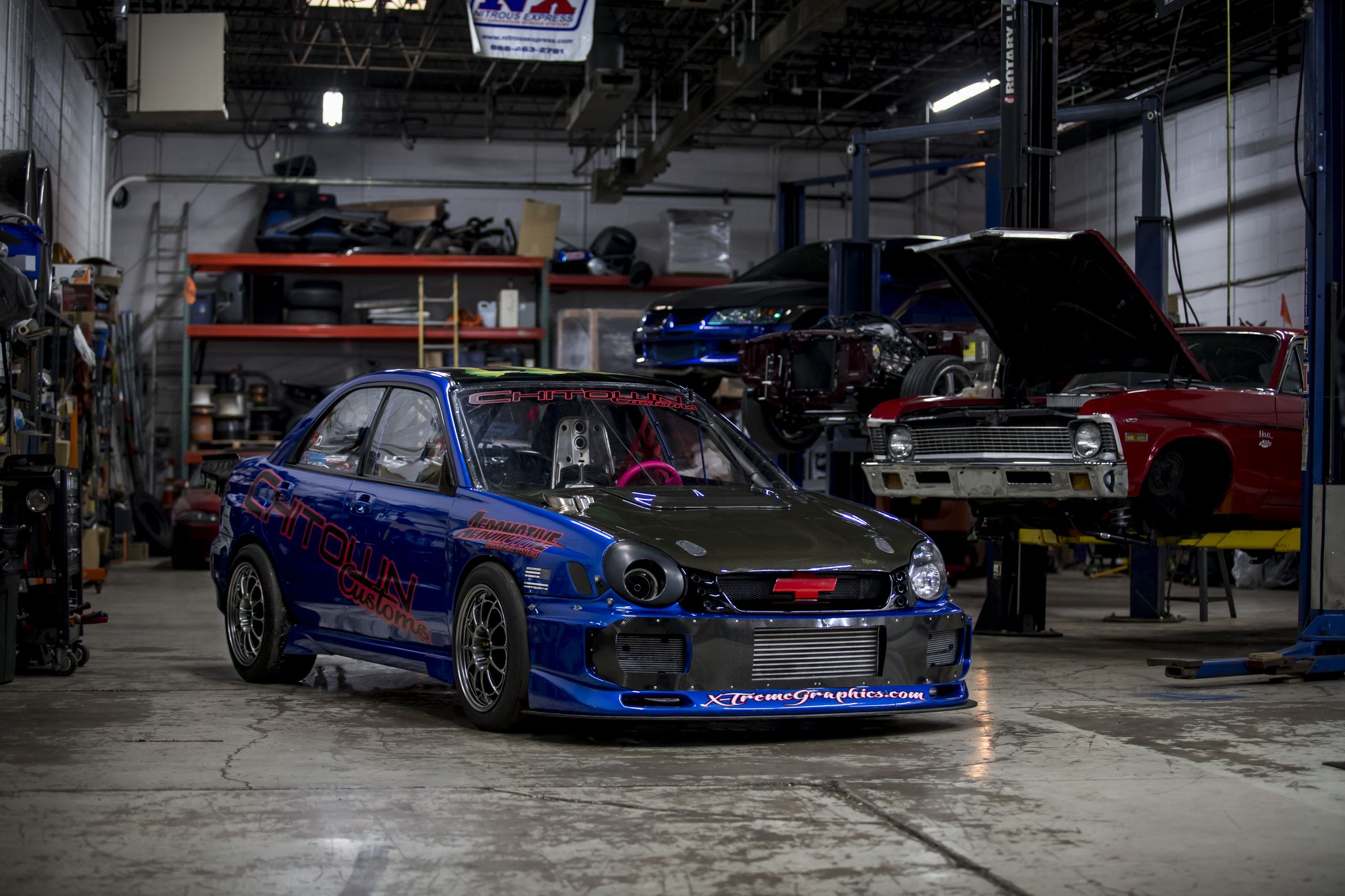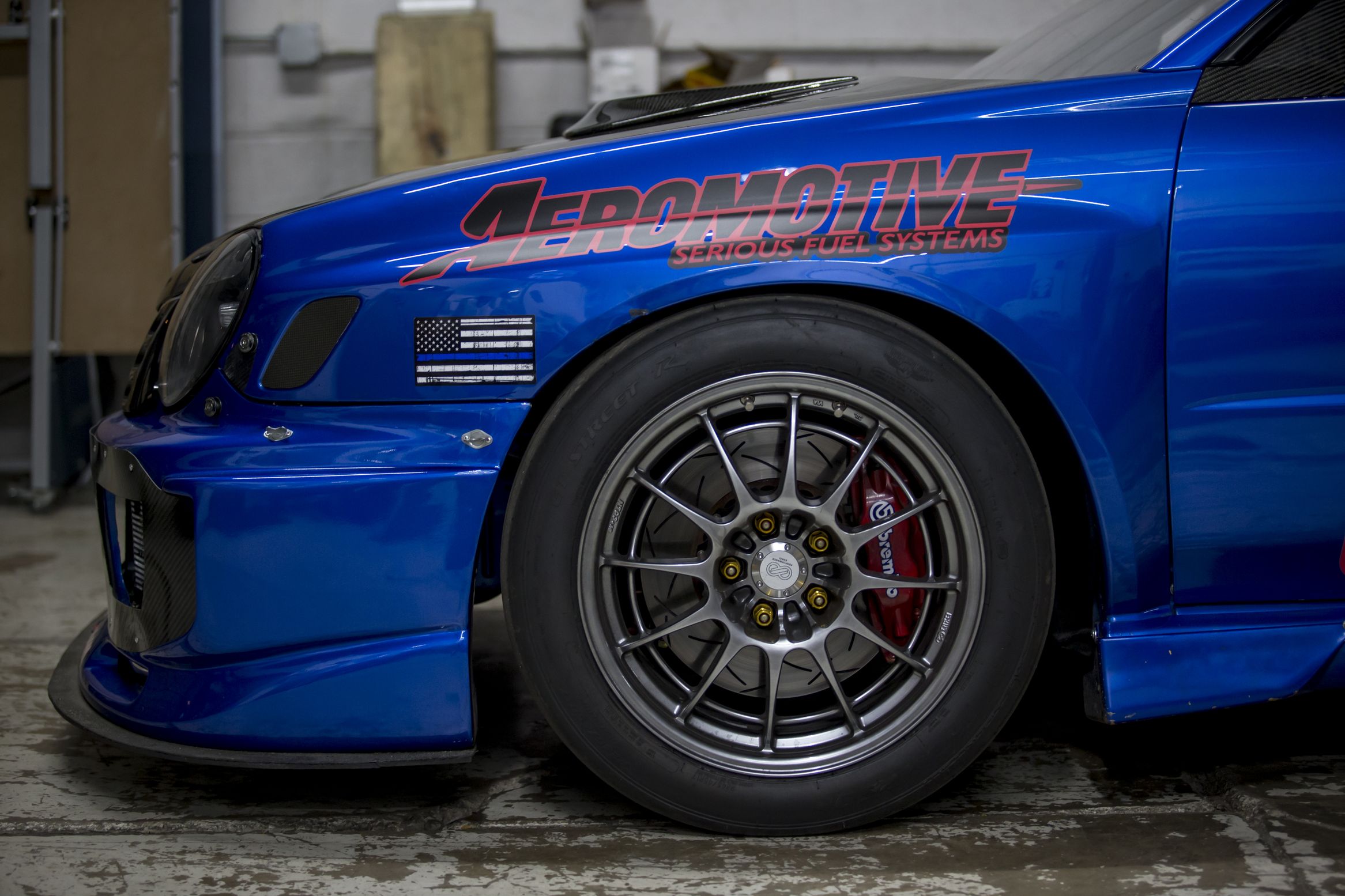Auto enthusiasts tend to be die-hard loyalists – Ford guys are Ford guys, Mopar folk stick with Pentastar hardware, and so on. Rarely do the flock stray, and to a tangible degree, that brotherhood is even stronger than usual among the Subaru crew. Whether it’s the always slightly off-kilter brand aesthetic, the company’s history of producing oddball models like the Brat and SVX, or the distinctive brap of the automaker’s flat-four boxer engine and its unequal length headers, there’s a certain level of personal identity ingrained into that particular community.
So with that in mind, you can imagine the furor that’s caused when Marcelo Rick’s 2003 WRX pulls up to the staging lanes to tear down the quarter-mile and the roar emanating from the custom-fabricated exhaust sounds more like Detroit than Shibuya.
From a quick glance in the staging lanes, one might be forgiven for assuming that Chitown Customs' Subaru was a fairly typical heavily boosted, boxer engine-powered import drag car. A decade ago, they would have been more or less on the money. But after detonating enough Subaru engines to make racing the car an unfeasible proposition, Rick decided to take the WRX in another direction.
As the owner and operator of Chitown Customs in Wood Dale, Illinois, Rick founded the shop in 2014 to offer general repair service as well as performance modifications and fabrication work. “We didn’t start with the intention of specializing in a particular style or make of performance builds,” Rick says. “But everyone has always assumed we’re Subaru specialists because I’ve always had a Subaru.”
These days, their performance focus is shifting toward the eight-cylinder variety. “We do pretty much any kind of build, but these days we’re focusing more towards old-school muscle car stuff,” he tells us. “And that’s part of the reason we decided to make the change on my WRX.”

While they’re not overt about it, Chitown Customs doesn’t try to hide the fact that the WRX is boasting V8 power. If the trunk badge and the big red bowtie on the grille aren’t enough to tip off curious onlookers, the burly rumble coming from the uncorked exhaust should do the trick.
Keen-eyed observers will note the bowtie on the Subaru’s grille, a not-so-subtle hint at the unlikely powerplant that lurks underneath the Japanese bodywork. We got the skinny from Rick about the inspiration behind this wild build, how it all came together, and where they’re headed with it.
The Path To LS Power
“I kept going through motors,” Rick explains. “Every year I’d go through one, two, three, four motors – it starting getting old. And no matter what you do to those motors – sleeving, not sleeving, filling the block, etc – they just don’t last as long as an LS block would last. Instead of changing a motor every three or four races, I’ve only got to do spark plugs in an LS. The EJ just wasn’t doing with it had to do.”
LS power or not, Rick's WRX definitely looks the business. Up front, custom work is clearly evident from the air intake where the passenger side headlight used to live and the array of heat exchangers lining the lower fascia, to the pipes sticking up through the hood. The Subaru gets the power to the ground through a set of Mickey Thompson ET Street R radials. The trunk's days of serving as storage are clearly long gone as the cage supports, battery, fuel cell, and Aeromotive fuel system hardware now occupy that space.
After a friend of his bought a new ’04 WRX STi, Rick decided to acquire a WRX for himself. At that point, Rick’s 2003 WRX was essentially a showroom stock machine. “Six months after I bought it I started modifying the car and had some fun with it for three or four years,” he tells us. “Then the small turbo setup that I did with it blew up the stock motor, so after that, I just got crazier and crazier with the build, and it was never the same car again.”
At its Subaru-powered peak, the WRX was pushing roughly 800 horsepower to the ground and was good for a personal best e.t. of 10.0 at 143 mph. “The car wouldn’t hook because I was running a rear-wheel drive-biased setup. And after spending about $40,000 on that build, that motor only lasted me 15 passes. That’s like, two race weekends.”

When Rick grenaded a $40,000 Subaru race engine after just two race weekends, he decided to put the car out to pasture for a while. It sat in the shop for years just collecting dust while he considered his options. After a series of low-ball offers to buy the car without an engine, Rick says he decided to finally heed the advice of his friends who were running V8s and look into putting an LS in it. He hasn’t looked back since. “Instead of changing a motor every three or four races, I’ve only got to do spark plugs in an LS,” he explains. “The EJ just wasn’t doing with it had to do.”
Rick’s motor-killing habit was getting expensive. “After that motor blew up, the car sat for three years,” he says. “I wanted to call a junkyard to just come pick it up, but I decided to keep it.”
It was clear he was going to have to get inventive if he wanted to push the Subaru further without going broke in the process.
A New Lease On Life
“The build took about two years,” Rick says. “For five or six years before I decided to do this, all my friends with V8s were telling me to put an LS in it. I never did – I just didn’t feel like doing all the work. The car sat for years and I was literally just going to sell the car as it sat – it was more or less race ready but without a motor. But people kept low balling me, so I didn’t want to sell it. So it sat in the shop for a few years collecting dust and I didn’t know what to do with it. Then we decided to start doing some fabrication to see if anything would fit, and I had a guy make me a subframe for the car. Everything just fit like a glove.”
Under the hood sits a built 327ci LSX motor that gets boost from a single 96mm turbocharger. While Rick wasn't willing to divulge the specifics of the engine internals (he runs the car in outlaw and grudge match racing), he says the combination makes north of 1,000 horsepower. The grunt is routed to the rear wheels through a TH400 transmission.
The engine bay is now home to a 327-cube LSX V8 that’s backed by a TH400 gearbox. Forced induction is provided by a BorgWarner 96mm turbo, and a killer set of custom fabricated headers routes the exhaust out of the engine bay directly through the hood.
The car sat for years and I was just going to sell the car as it was – it was race ready but without a motor. But people kept low balling me, so I didn’t want to sell it. We decided to start doing some fabrication to see if anything would fit, and I had a guy make me a subframe for the car. Everything just fit like a glove. – Marcelo Rick, Chitown Customs
To get the LS powerplant to work with the Subaru platform, both the front and rear sections of the chassis are now tubular. And, as you can imagine, it took quite a bit of custom work to get all the hardware to play together nicely. “The turbo kit and intercooler – everything on the cold side – is custom fabricated, one-of-one stuff,” he tells us. “We also have a nitrous system hooked up, but we haven’t used that yet.”
As for engine internals, those specs are going to remain a secret for the time being. “It’s definitely not stock internally, but we do a lot of outlaw and grudge races, so we can’t really talk too much about what’s in there. I can say that the car makes more than 1,000 horsepower as it sits.”

The cabin of the WRX is pure race car stuff. Gone is any semblance of the factory interior, replaced by a lightweight race seat, a digital performance data display, quick release steering wheel, safety equipment, and a purpose-built center stack that houses the gauges and display that monitor the engine vitals. “We also have a nitrous system hooked up, but we haven’t used that yet,” Rick told us.
As far as Rick’s decision to go with an LS versus another V8 powerplant, he says that he’s actually always been a GM guy at heart. “I had a Corvette right out of high school, and I had so much fun in that car. But I also had a Mustang Cobra R for a couple years, so I got to see both sides of the Chevy vs Ford thing. The Cobra gave me nothing but problems, so I’ve never really been a fan of the Ford motors. I just kept lifting heads on that 351 Windsor, and I got sick of it. So I decided to stick with Chevy – never had a problem with the Chevys. Yet.”
I had a Corvette right out of high school, and I had so much fun in that car. But I also had a Mustang Cobra R for a couple years, so I got to see both sides of the Chevy vs Ford thing. The Cobra gave me nothing but problems, and I got sick of it. So I decided to stick with Chevy – never had a problem with the Chevys. Yet.
The Upcoming Race Season And Beyond
“The engine swap put us in a different class, but I never really cared for the old class anyway,” Rick says. “I really do this more for fun. I’m not trying to build anything faster than anybody else or break any records. I just want to go fast.”
Although the WRX has yet to set a time since the heart transplant, by the shop’s calculations, it should be plenty quick. “TX2K will be the first time we send it down the track,” Rick tells us. “With the power-to-weight ratio of the car, it should get into the high 7s. Unless we go balls out and throw a rod through the fender.”

In its most potent Subaru-powered configuration, Rick says the WRX had a personal best e.t. of 10.0 at 143 mph with a 1.620 60-foot time. With a rear-biased setup, they were having a tough time getting the car to hook. Though the WRX has yet to hit the drag strip under LS power, Rick says the math equates to a potential time in the high seven-second range. We’ll find out how close that estimate is to reality when the crew takes the car to Royal Purple Raceway for the TX2K in March. As if that weren’t fast enough, Rick says they already have some long-term plans for the build that includes tubbing the car and adding a big-cube LSX powerplant, a twin-turbocharged setup, and a FAB9 rearend.
But Rick says they’re not done with the car by any means. “The next plan for the car will be to move from small displacement to a bigger motor – maybe a 427 or something in the 500s,” he says. “And we’re also going to add another turbo to the other side to make it a twin-turbo setup and put a FAB9 rear end out back. We’re going to tub it and make it a small-tire car, and if we have enough space, maybe a big-tire car. Those are the main long-term plans.”
In the meantime, we expect this thing to make some waves at Royal Purple Raceway in Baytown, Texas this March.



























